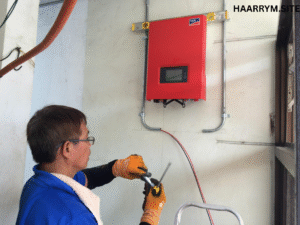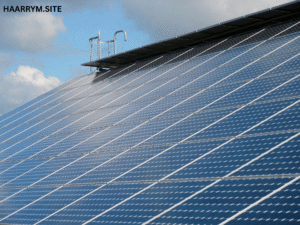Solar powered inverters have been more important in home, business, and industrial solar systems as the planet moves towards renewable energy. Understanding how these inverters operate, why they are necessary, and how to choose the correct one is crucial given growing interest in solar energy systems.
From functionality and varieties to installation and cost-saving advice, this comprehensive guide will break down what you need to know about solar powered inverters.
🌟 What Is a Solar Powered Inverter?
Usually used in homes and businesses, a solar powered inverter is a device that transforms direct current (DC) energy produced by solar panels into alternating current (AC).
Your solar panels would be essentially worthless for running home appliances as TVs, lights, or refrigerators without an inverter. Stated differently, the inverter serves as the link between your solar panel system and your source of useable power.
⚙️ How Does a Solar Powered Inverter Work?
Let’s break the process down simply:
-
Solar panels absorb sunlight and generate DC electricity.
-
This electricity is sent to the inverter.
-
The inverter converts DC into AC power.
-
The AC power is then distributed through your home’s electrical system.
-
Any excess energy can be stored in batteries or sent back to the grid (in grid-tied systems).
A high-quality inverter ensures maximum energy conversion efficiency, which directly affects your solar system’s performance.
🔋 Types of Solar Powered Inverters
Not all inverters are created equal. There are several types to choose from, each with its own use case.
1. String Inverters (Central Inverters)
-
Most common in residential solar systems.
-
All solar panels are connected in a series (string).
-
One inverter handles power conversion for all panels.
Pros: Cost-effective, easy maintenance
Cons: Efficiency drops if one panel is shaded or dirty.
2. Microinverters
-
Each solar panel has its own inverter.
-
Optimizes power output individually.
Pros: Better performance in shaded areas, scalable
Cons: Higher upfront cost
3. Power Optimizers
-
Similar to microinverters but still use a central inverter.
-
Each panel has an optimizer that conditions the DC power before it reaches the inverter.
Pros: Great for partially shaded roofs, more affordable than microinverters
Cons: Slightly more complex installation
4. Hybrid Inverters (Battery-Based Inverters)
-
Integrates a solar inverter with battery storage.
-
Can work with or without the grid.
Pros: Best for backup power and energy independence
Cons: Expensive but offers long-term ROI
💡 Why You Need a Solar Powered Inverter
Still wondering why a solar powered inverter is important? Here are some compelling reasons:
✅ Converts Solar Energy into Usable Power
Without it, your solar panels won’t power anything in your home. Simple as that.
✅ Maximizes Efficiency
Modern inverters optimize the energy output of your solar panels, ensuring you get the best performance.
✅ Monitors System Performance
Many inverters come with built-in monitoring systems or smartphone apps to track your energy production and usage.
✅ Ensures Safety
Good inverters come with automatic shut-off systems in case of a power surge or other risks.
✅ Grid Compliance
In grid-tied systems, inverters ensure your solar energy is compatible with the utility grid, allowing for net metering and other benefits.
📈 Benefits of Using a Solar Powered Inverter
There’s more to solar inverters than just power conversion. Here are some long-term advantages:
1. Cost Savings
By using solar energy efficiently, you can significantly reduce your electricity bill.
2. Eco-Friendly
Solar power is renewable and clean. A good inverter ensures minimal energy loss, making your setup greener.
3. Energy Independence
Especially with hybrid inverters, you can reduce or eliminate your reliance on the power grid.
4. Increased Property Value
Homes with solar systems—and especially those with high-efficiency inverters—often sell faster and for higher prices.
5. Durability and Low Maintenance
Most solar inverters last 10–15 years and require minimal maintenance if installed correctly.
🔧 Installation Tips for Solar Powered Inverters
Installing a solar powered inverter isn’t a simple plug-and-play job. It’s a specialized task that requires professional attention.
Here are some important things to consider:
📍 Location
-
Install in a shaded, well-ventilated area.
-
Avoid direct sunlight and moisture for longevity.
📏 Sizing the Inverter
-
Your inverter’s size should match your solar panel capacity.
-
Example: A 5 kW solar system typically needs a 5 kW inverter.
🔗 Wiring and Configuration
-
Ensure correct wiring and grounding for safety.
-
Choose appropriate circuit breakers and fuses.
📱 Monitoring Features
-
Choose inverters with built-in monitoring tools.
-
Cloud-based apps help you track energy production in real time.
💸 Solar Powered Inverter Costs: What to Expect
The price of a solar powered inverter depends on type, brand, and capacity.
| Type | Cost Range (USD) |
|---|---|
| String Inverter | $1,000 – $2,000 |
| Microinverters | $1,500 – $3,000 |
| Power Optimizers | $1,300 – $2,800 |
| Hybrid Inverter | $2,000 – $5,000+ |
Note: These prices exclude installation fees. Always get multiple quotes before finalizing.
🛠️ Maintenance & Troubleshooting
Solar powered inverters are generally low-maintenance, but here’s how to keep them in top shape:
Regular Checks
-
Monitor error codes or alerts.
-
Check cooling fans and vents for dust buildup.
Software Updates
-
Some inverters receive firmware updates; ensure yours is up to date.
Professional Inspection
-
Schedule a professional check-up once a year.
Common Issues:
-
Overheating
-
No power output
-
Error messages or fault lights
-
WiFi disconnection (for smart inverters)
If you notice these problems, contact your installer or inverter manufacturer.
🌍 Best Brands of Solar Powered Inverters in 2025
Here are some trusted names in the solar inverter market:
🔹 SMA Solar Technology
-
German engineering
-
Known for durability
🔹 SolarEdge
-
Ideal for systems with shading
-
Great monitoring features
🔹 Enphase Energy
-
Market leader in microinverters
🔹 Fronius
-
Reliable string inverters
-
Excellent customer support
🔹 Growatt
-
Affordable yet efficient
-
Great for small to medium-sized systems
🧠 Buying Guide: What to Look for in a Solar Powered Inverter
Here’s a quick checklist:
-
✅ Match inverter size to solar array
-
✅ Choose type based on shading and layout
-
✅ Look for efficiency ratings (above 95% is ideal)
-
✅ Consider battery compatibility
-
✅ Go for well-known brands with warranties (10+ years)
-
✅ Opt for remote monitoring features
-
✅ Check for grid-tied and off-grid options
🔮 The Future of Solar Powered Inverters
The solar industry is rapidly evolving. Inverters are becoming smarter, more efficient, and more connected.
Key Trends to Watch:
-
AI-based optimization
-
Integrated EV charging
-
Blockchain-based energy trading
-
IoT-connected energy management
These innovations mean better savings and smarter homes for solar users.
📝 Final Thoughts: Is a Solar Powered Inverter Worth It?
Correct. A solar powered inverter is a necessary purchase whether your goals are energy independence, environmental consciousness, or bill reduction.
The correct inverter not only makes sure your whole solar system runs at its best but also efficiently captures the electricity from the sun.
🚀 Ready to Go Solar?
Before buying a solar powered inverter, consult a certified solar installer who can evaluate your energy needs, panel layout, and budget. Make an informed decision and enjoy the long-term benefits of solar energy!

